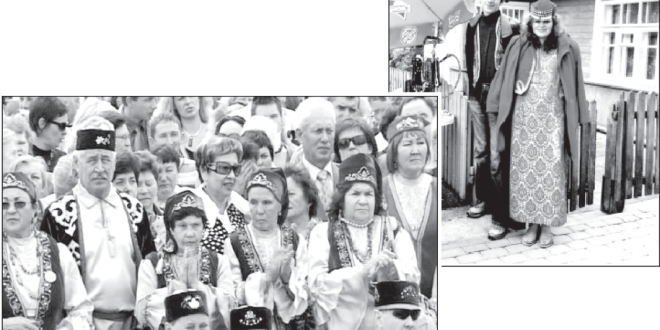The first Lithuanian State, the Grand Duchy of Lithuania (GDL), which existed from the thirteenth to the eighteenth century, was basically an emanation of the Lithuanian people, but also a multinational and multicultural state. The Lithuanians concentrated at the core were about one third of its population; the rest were Ruthenians (ancestors of the Belarusians and Ukrainians), Poles, Germans, Jews, Scots, Italians, Armenians, Latvians, Roma (Gypsies) and the Muslim ethnic minorities of Tatars and Karaim. Historiography has paid much attention to Christian and Jewish minorities, but little to the Tatars and Karaim. Why did these groups of Turkic-speaking Tatars and Karaim settle in the GDL during the Middle Ages? What is their story?
The Tatars
The Tatars likely originated from the Turkic nomadic tribes of Kipchaks in the northeastern Gobi Desert in the fifth century. These nomadic groups later became part of Genghis Khan’s army in the early thirteenth century, when a fusion of Turkic and Mongol elements took place, and the warriors from the steppe became known to Europeans as Tartars or Tatars. After the collapse of the vast Mongol Empire, the Tatars became identified with the Golden Horde, a state that contested the GDL over control of today’s Ukraine and Belarus. According to Michalo Lituanus (Michael the Lithuanian— identified as Mykolas Tiškevičius, the Lithuanian envoy to the Khanate of Crimea in 1537–1539) in his book De moribus tartarorum, lituanorum et moscorum (On the Customs of the Tatars, Lithuanians and Muscovites), the Tatars, who were “much more valiant in combat than the Muscovites,” became a cumbersome neigh- bor, harassing the southern territories of the GDL—the Rus’ lands of Podolia and Kiev known as the “Wild East” of Europe.
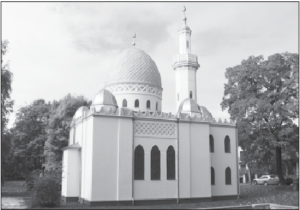
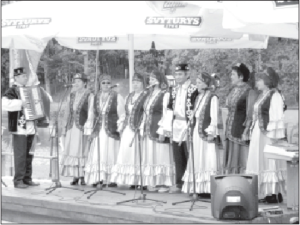
It is believed the Tatars first settled in the GDL in the early fourteenth century, when the Lithuanians expanded into the Rus’ lands. These Tatars wished to preserve their shamanistic religion and sought safety among the pagan Lithuanians. Towards the end of the fourteenth century, another wave of Tatars, Mus- lim in religion, settled in the GDL.
According to Polish historian Jan Dlugosz, Vytautas the Great (1350–1430) brought a Tatar group “with wives and children, and herds” as a war trophy from his campaigns on the Don and Volga Rivers in 1397. Some were given to his cousin, Jogaila, king of Poland. These were likely christened, but others retained their Muslim faith and their traditional way of life, settling around Vilnius, Trakai, Lida, Naugardukas, Gardinas and Kaunas to avoid the Wild East, where the chance of a clash with hostile Tatars was greatest. They became known as the Lipka Tatars from the Crimean Tatar name for Lithuania, Lipka.
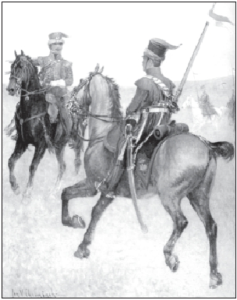
Famous for their stamina and loyalty, Tatar warriors were used for the personal guard of Vytautas the Great. Their light cavalry fought by his side in the Battle of Žalgiris (Grünwald) in 1410 that ended the threat of the Teutonic Order in the Baltic region. Later, the Lithuanian magnates, especially the Ostrogski and the Radvila families, rewarded the Tatars with land in return for service in their private armies. The Tatars then settled in Minsk, around Kiev and in Slutsk, expanding their range in the GDL. When Tatars became landowners, they had to provide troops to the Grand Duke’s army. During the sixteenth and seventeenth centuries they formed military banners that could be called up at anytime.
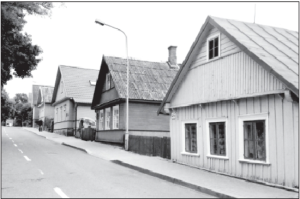
When the GDL’s finances were low (from the seventeenth century onward), the Tatars sold their manors to avoid regular military service and enlisted as mercenaries in the private armies of the magnates. Tatar regiments fought in the Radvila cam- paigns in the Livonian War (1558– 1583), the Battle of Vienna (1683) and the Polish-Lithuanian uprising in 1794. Armed with light lance, bow, saber and axe, their main tasks were reconnaissance and harassing retreating enemy forces.
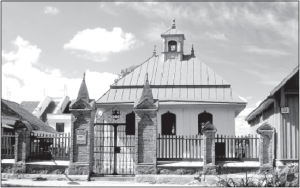
A major Tatar contribution to the Lithuanian military was their formidable cavalry, the uhlans, founded by a Lipka Tatar noble, Colonel Aleksander Ulan (died ca. 1740), who commanded a light cavalry regiment in the service of the Saxon grand dukes of the GDL, Augustus II and Augustus III. The name uhlan was later adopted by lancer regiments in the Prussian, Austrian and Russian armies. Between the two world wars, the Second Cavalry Regiment of the Lithuanian army was named “Birutė’s Uhlans.”
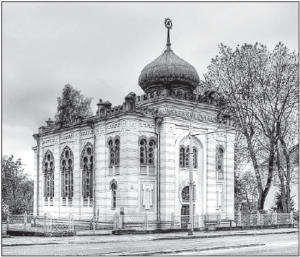
Lipka Tatars distinguished themselves during Napoleon’s 1812 Russia campaign. As soon as Napoleon crossed the border into Lithuania, he ordered the formation of a Tatar unit, that became part of his personal guard and which followed him throughout the entire campaign and even afterwards.
Not all Lipka Tatars were warriors. Some became burghers, who owned no land but made a living at skilled trades, especially processing leather and fur, transportation or gardening. The latter lived in the suburbs of Lithuanian towns and did not have citizen status. Other traditional Tatar vocations were making rugs and driving coaches. In Georg Braun’s description of Vilnius in his Civitates Orbis Terrarum (1576), there is a passage about the Tatars:
They earn a living by tilling the soil or working as coachmen or porters; in winter, the merchants avail themselves of their services when they want to be driven to the neighboring villages in two-wheeled carriages… The character of their horses is similar to theirs: they are strong and grim. They [the coachmen] feed on bad bread and garlic and lead a miserable life, using a board or a stone instead of a pillow…
The Lipka Tatars differed from other Muslims in the treatment of their women, who did not wear the veil and enjoyed a large degree of freedom.
In 1616, there were more than one hundred Tatar mosques in the Polish-Lithuanian Commonwealth. The wooden mosque of Raižiai in the Alytus District was built in 1556, the oldest of four to survive in Lithuania; another is in Kaunas, and two are in Nemėžis and Keturesdešimt Totorių (Forty Tartars) villages in Vilnius District. Despite their Muslim faith, the Tatars maintained traditions from their pagan past, such as the sacrifice of bulls in their mosques on major religious holidays.
The language of the Muslim Liturgy was Arabic, and Arabic script was used in Tatar literature during the fourteenth and fifteenth centuries. From the sixteenth century on, most of their religious and secular texts were written in Ruthenian and Polish, but in Arabic letters. The earliest copy of the Koran in Polish dates from the early nineteenth century. The Lipka Tatars lost their native language rather early; by the sixteenth century they mainly spoke Ruthenian and Polish.
After the partitions of the Polish-Lithuanian Commonwealth, many Lipka Tatars converted to Roman Catholicism or Orthodox Christianity. Their titles of nobility were recognized in the Russian Empire, and they were eligible to hold state office (a privilege forbidden them in the GDL). In the early twentieth century, eighteen generals in the Russian army were of Lipka Tatar descent.
After Lithuania regained independence in 1918, the 1923 census showed approximately 973 Lipka Tatars living in the districts of Kaunas, Alytus, Trakai, Zarasai and Ukmergė. There were several Tatar newspapers, and in 1929, a Tatar museum opened in Vilnius, which was then under Polish occupation. In 1930, the Tatars of Kaunas built a stone mosque, the only such mosque standing in Lithuania today. Closed by the Soviets, it reopened after the reestablishment of independence and was recently renovated.
After 1945, when Lithuania had regained the Vilnius region, the number of Tartar communities in Lithuania doubled (mostly in the Vilnius region and particularly in the village of Nemėžis). In Soviet times, the only mosque in use was that of Raižiai, which became a cultural center for all Lipka Tatars. It is estimated that between three and four thousand Tatars live in Lithuania today. A new Tatar museum opened in the village of Sabatoniai in 2007.
The most celebrated Lipka Tatars are the novelist Henryk Sienkiewicz (1846–1916) and the actor Charles Bronson (1921–2003). Sienkiewicz’s family were impoverished Polish nobles on his father’s side, descended from Lipka Tatars in the GDL. Charles Bronson was the eleventh of fifteen children born to a Lipka Tatar immigrant father and a Lithuanian American mother born in the coal mining town of Tamaqua, Pennsylvania. His father, Walter Bunchinski hailed from Druskininkai. Charles spoke Lithuanian and only learned to speak English well when he was a teenager.
Other notable Lipka Tatars were Brunonas Abakanovičius (1852– 1900), the inventor of the Intergraph (a form of mathematical integrator, patented in 1880); Jokūbas Sinkevičius, a doctor of philosophy and Orientalist, who became mufti of the Lithuanian Tatars after 1939; Stanislovas Kričinskis, who wrote and published the first book about Lithuania’s Tatars in 1938, describing their origin, way of life, religion, customs and traditions; Aleksandas Sulkevičius, one of the cofounders of the Polish Socialist Party; and Loreta Asanavičiūtė, one of the thirteen victims, and the only woman, killed by Soviet troops when they stormed the Vilnius TV Tower on January 13, 1991.
The Karaim
The Karaim (Karaimai in Lithuanian) or Karaites have lived in Lithuanian lands for more than six hundred years. Like the Tatars, Karaim are descended from the Kipchaks. According to Karaite tradition, it was Vatat Bij (Vytautas the Great, whose cult is strong in their tradition), who brought 380 Karaite families to the GDL in 1397, after his campaign against the Golden Horde, settling them in Trakai and Lutsk. In return for land, they guarded the town of Trakai and its castle, and a Karaite quarter arose in Trakai. During the seventeenth century, they expanded to Biržai, Kruonys and Pasvalys.
The Lithuanian Metrika, or archive of the GDL, is of limited use in researching Karaite history because the name Karaim or Karaite is of recent origin and not used consistently. The term refers to a religious denomination in a 1506 petition addressed to the Grand Duke by “all the Jews of Lutsk, both rabbinical and Karaite.” The Karaim were called “Jews” until the seventeenth century because they used the Hebrew script. But Karaism is characterized by the recognition of the Tanakh (the first five books of the Old Testament) alone as its supreme authority for religious law and theology, and rejects the oral tradition of the Talmud of rabbinic Judaism. Interesting stories have survived from the nineteenth century about the Karaite temple ( kenesa ) in Trakai, said to be modeled after the ancient temple in Jerusalem, with the Ten Commandments inscribed upon the altar.
The Lithuanian Grand Dukes granted privileges to the Karaim, especially the right to self-rule, with a Karaite chief magistrate at the head appointed by the vaivode of Trakai or his deputy. This privilege was an original product of GDL law, defining the place of non-Christians in a multicultural society. The Karaim also enjoyed customs exemptions that, before the Second Lithuanian Statute (1566), not even the gentry were exempt from. No other non-Christian community in the GDL enjoyed this benefit. The principal body of law for the Karaim was the secular and religious code compiled in the sixteenth century by Elryahu Beshryats and his pupil, Kaleb Afendopulos. In 1531, the Karaite Statute was published in Istanbul and served as a basis for the domestic life of the Trakai and Lutsk Karaim.
In 1690, Karaite traditions and way of life were investigated academically for the first time. Karl XI, King of Sweden, sent Gustav Peringer, pro- fessor of Oriental languages at Uppsala University, to the GDL to collect data on the Karaim. The first to write a scientific work on the subject, Peringer wrote: “The Karaim differ strongly from rabbinical [Jews] not only in their customs, but also in their language and religion, and especially in their facial features. Their native tongue is Tatar, or, to be more precise, Turkic, into which they translate the sacred books used in their kenesas and schools…” Peringer concluded the Karaim were not a Jewish sect, but a distinct nation with a monotheistic religion of their own, Karaism.
Thanks to the interest of a Swedish king, a Swedish professor wrote the first scientific work about the Karaim; but the inhabitants of the GDL already knew the Karaim had little in common with Jews. Peringer made a contribution to this ethnic divorce, but since the eighteenth century, the people of the GDL regarded the Karaim as a distinct religious and linguistic community. Once they had been so defined, a positive stereotype of the Karaim formed among Lithuanians and Poles that was distinct from the negative stereotype of the Jew.
Misfortune hit in 1710, when plague struck the GDL and a large number of Karaim died. After the partitions of the Polish-Lithuanian Commonwealth, the Lithuanian Karaim continued to enjoy their privileges and a Karaite Spiritual Board was founded in Trakai in the middle of the nineteenth century. According to the 1897 census, 12,894 Karaim lived in the Russian Empire; most in Crimea. At that time, around 500 lived in the territory of present-day Lithuania. By 1918, when the Lithuanian state was reestablished, the figures had increased a little, but after the loss of Vilnius and Trakai to Poland, the 1923 census showed only 141 in Lithuania. Today, most Karaim live in Vilnius. In 2001, there were 138 in the Lithuanian capital, 65 in Trakai and a few in Kaunas, Lentvaris and Grigiškės.
Today the Karaite language is endangered. The only community to preserve it is in Lithuania, but fewer than fifty people are still able to use it in conversation. They have preserved many words that no longer exist in other Turkic languages. Until the twentieth century, Karaite literacy was based on knowledge of Hebrew, and Hebrew characters were used to write Karaite; but after Lithuanian independence was restored in 1990, the Karaim adopted a new orthography based on the Lithuanian alphabet.
Many outstanding Karaite individuals contributed to Lithuanian culture. The theologian Solomon of Trakai (1650–1725) was invited to Sweden’s Uppsala University to lecture on the Lithuanian Karaim. In 1698, the historian Mordekhai Nisanovičius wrote a treatise on their origin, later (1721) published in Latin ( Notitia Karaerorum ). The private physicians of several grand dukes and magnates of the GDL were Karaim: Ezra Nisanovičius (1596–1666) served the Radvila (Radziwiùù) family and later Jonas Kazimieras Vaza, Grand Duke of Lithuania; Abraham Moskievičius served the notable Višniovieckis (Wisniowiecki) family. The most famous Karaim was the sixteenth century theologian Isaac ben Abraham from Trakai, an apologist for Karaism and Judaism in disputes with Christians and Muslims (Lipka Tatars). In 1681, his treatise in Hebrew ( Hizzuq Emunah ) was published in Latin, then in English, Polish, French and other languages. His work influenced representatives of the Polish, Lithuanian, French and English Enlightenment.
In modern times, Karaim worthy of mention are Simon Kobecki (1865–1933), a poet who wrote the first book of secular Karaite poetry ( Irlar ) in 1904; the Lithuanian Army Colonel Leonas Rajeckas (1892 –1943), who died in the Norilsk labor camp in Siberia; and Hadži Seraja Chan Šapšalas (Hajji Seraya Khan Shapshal 1873– 1961).
Born in the Crimea, Šapšalas was an Orientalist, a doctor of philosophy and a leader of the Crimean Karaim; but in 1927, he was elected supreme spiritual leader of the Polish and Lithuanian Karaim. In 1928 he moved to Vilnius where he taught Turkic languages and was the spokesman for the local Karaim community.
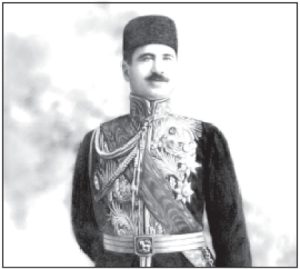
notable leader of the Lithuanian Karaim.
In 1938, Šapšalas founded a Karaite museum in Trakai to display his extensive personal collection of historic and ethnographic Karaite artifacts, but the onset of World War II and the Soviet invasion prevented its opening. His collection was first kept at his home, and then later transferred to the Museum of History and Ethnography in Vilnius and the Trakai Castle Museum.
In 1947, Šapšalas began his work at the Institute of History of the Lithuanian Academy of Sciences in Vilnius, where he published a number of books about the history and language of the Karaim of Lithuania and the Crimea that are of great value to historians. A Karaite Ethnographic Museum was finally opened in Trakai in 1967, after Šapšalas had already died.
 DRAUGAS NEWS Lithuanian World Wide News in English
DRAUGAS NEWS Lithuanian World Wide News in English
